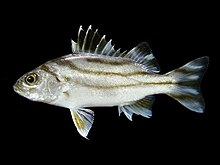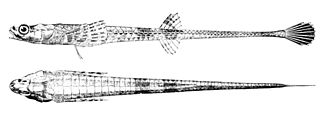
Agonidae is a family of small, bottom-dwelling, cold-water marine fish. Common names for members of this family include poachers, Irish lords, sea ravens, alligatorfishes, starsnouts, hooknoses, and rockheads. They are notable for having elongated bodies covered by scales modified into bony plates, and for using their large pectoral fins to move in short bursts. The family includes about 59 species in some 25 genera, some of which are quite widespread.

The flagtails are a family (Kuhliidae) of perciform fish of the Indo-Pacific area. The family consists of several species in one genus, Kuhlia. Most are euryhaline and often found in brackish water, but the genus also includes species restricted to marine or fresh water.
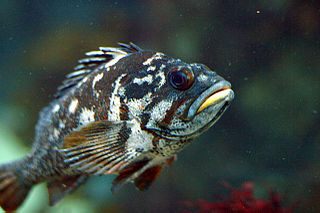
Sebastinae is a subfamily of marine fish belonging to the family Scorpaenidae in the order Scorpaeniformes. Their common names include rockfishes, rock perches, ocean perches, sea perches, thornyheads, scorpionfishes, sea ruffes and rockcods. Despite the latter name, they are not closely related to the cods in the genus Gadus, nor the rock cod, Lotella rhacina.

Sweepers are small, tropical marine perciform fish of the family Pempheridae. Found in the western Atlantic Ocean and Indo-Pacific region, the family contains about 26 species in two genera. One species is the target of subsistence fisheries in Japan, where the fish is much enjoyed for its taste. Sweepers are occasionally kept in marine aquaria.
Zoarces is a genus of marine ray-finned fishes belonging to the family Zoarcidae, the eelpouts. It is the only genus in the subfamily Zoarcinae. These eelpouts are found in the northern Atlantic and northern Pacific Oceans.
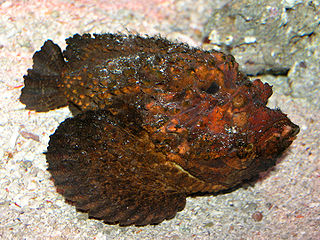
Synanceiinae is a subfamily of venomous ray-finned fishes, waspfishes, which is classified as part of the family Scorpaenidae, the scorpionfishes and their relatives. These fishes are found in the Indo-Pacific oceans. They are primarily marine, though some species are known to live in fresh or brackish waters. The various species of this family are known informally as stonefish, stinger, stingfish and ghouls. Its species are known to have the most potent neurotoxins of all the fish venoms, secreted from glands at the base of their needle-like dorsal fin spines. The vernacular name, stonefish, for some of these fishes derives from their behaviour of camouflaging as rocks. The type species of the family is the estuarine stonefish.

Chironemus is a genus of marine ray finned fish, commonly known as kelpfishes, belonging to the family Chironemidae. They are found in the temperate waters of the Southern Pacific Ocean.

Haemulidae is a family of fishes in the order Perciformes known commonly as grunts. It is made up of the two subfamilies Haemulinae (grunters) and Plectorhynchinae (sweetlips), which in turn contain about 133 species in 19 genera. These fish are found in tropical fresh, brackish, and salt waters around the world. They are bottom-feeding predators, and named for the ability of Haemulinae to produce sound by grinding their teeth. They also engage in mutualistic relationship with cleaner gobies of genus Elacatinus, allowing them to feed on ectoparasites on their bodies.
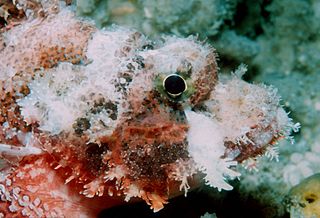
Sebastapistes is a genus of marine ray-finned fish belonging to the family Scorpaenidae, the scorpionfishes. The fishes in this genus are found in the Indian and Pacific Ocean.

Scorpaenopsis is a genus of marine ray-finned fish belonging to the family Scorpaenidae, the scorpionfishes. The fishes in this genus are found in the Indian and Pacific Ocean.

Parascorpaena is a genus of marine ray-finned fish belonging to the family Scorpaenidae, the scorpionfishes. They are native to the Indian Ocean and the western Pacific Ocean.

Bembridae, the deep-water flatheads, are a family of bottom-dwelling ray-finned fishes. They are found in the Indian and western Pacific Oceans.
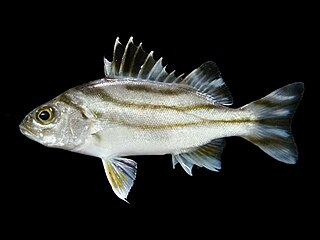
Terapon jarbua, the jarbua terapon, crescent grunter, crescent banded grunter, crescent perch, spiky trumpeter, thornfish or tiger perch, is a species of ray-finned fish, a grunter of the family Terapontidae. It occurs in the Indo-Pacific. it is an important commercial species within its range and is sometimes found in the aquarium trade where it is known as "target fish" for the pattern visible from above.

Terapon, also known as the grunters or trumpeters is a genus of ray-finned fish in the family Terapontidae, the grunters.
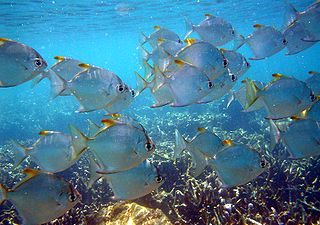
Monodactylus is a genus of moonyfishes found in fresh, brackish and marine waters from the eastern Atlantic, through the Indian to the western Pacific oceans.
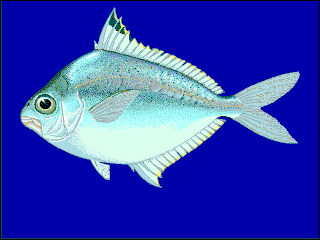
Eubleekeria splendens, common names splendid ponyfish and blacktip ponyfish, is a species of ponyfish.

The Eastern striped grunter is a species of marine ray-finned fish, a grunter from the family Terapontidae. It is found in the Indo-Pacific region where it is found in coastal waters and is an omnivore.

Hephaestus is a genus of freshwater ray-finned fish, grunters from the family Terapontidae.
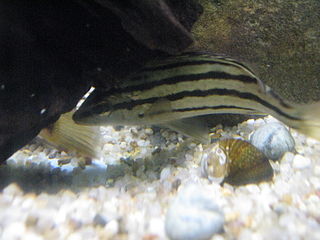
The sharpbeak terapon is a species of ray-finned fish, a grunter from the family Terapontidae. It is found in the coastal waters of Asia from southern Japan to the Philippines.

The crocodile flathead is a species of marine ray-finned fish belonging to the family Platycephalidae, the flatheads. It is found in the western Pacific Ocean.
